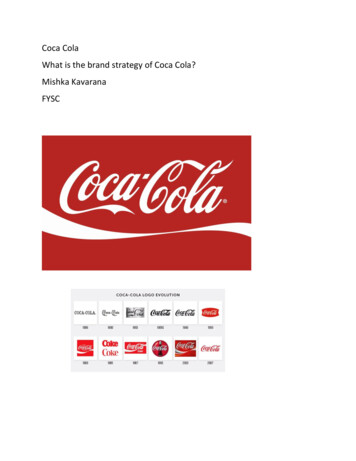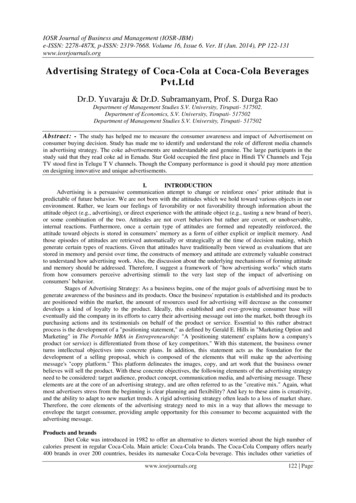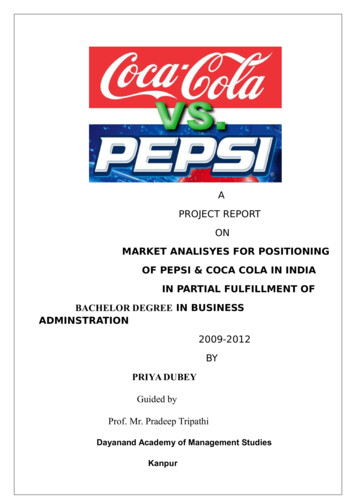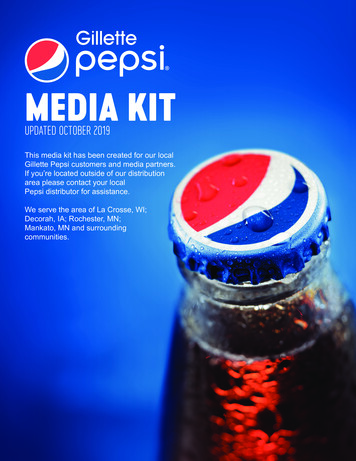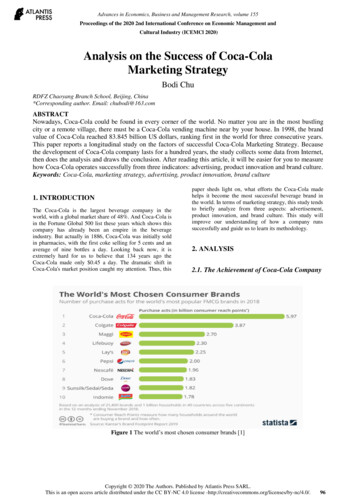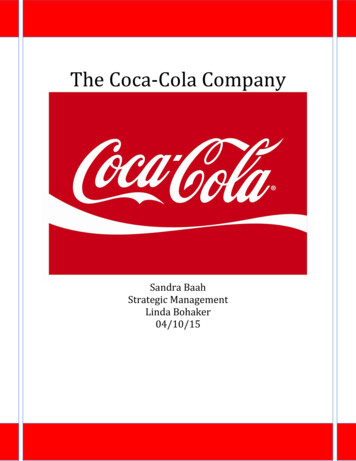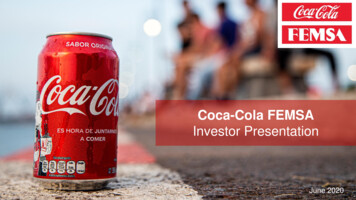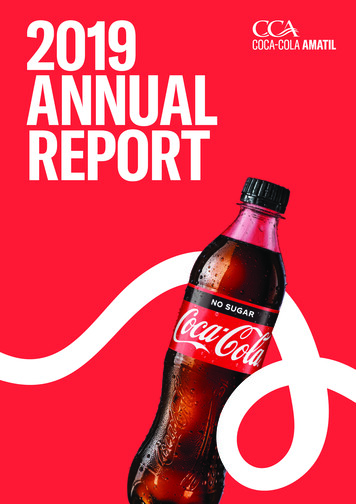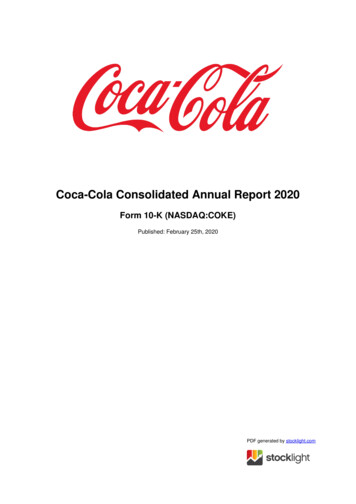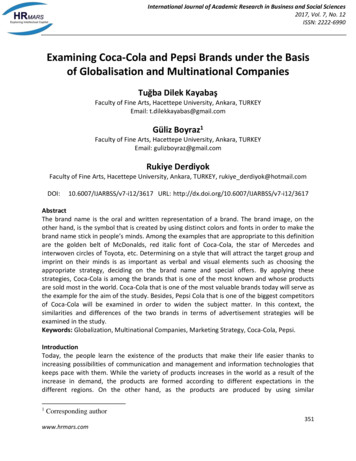
Transcription
International Journal of Academic Research in Business and Social Sciences2017, Vol. 7, No. 12ISSN: 2222-6990Examining Coca-Cola and Pepsi Brands under the Basisof Globalisation and Multinational CompaniesTuğba Dilek KayabaşFaculty of Fine Arts, Hacettepe University, Ankara, TURKEYEmail: t.dilekkayabas@gmail.comGüliz Boyraz1Faculty of Fine Arts, Hacettepe University, Ankara, TURKEYEmail: gulizboyraz@gmail.comRukiye DerdiyokFaculty of Fine Arts, Hacettepe University, Ankara, TURKEY, rukiye 7 URL: actThe brand name is the oral and written representation of a brand. The brand image, on theother hand, is the symbol that is created by using distinct colors and fonts in order to make thebrand name stick in people’s minds. Among the examples that are appropriate to this definitionare the golden belt of McDonalds, red italic font of Coca-Cola, the star of Mercedes andinterwoven circles of Toyota, etc. Determining on a style that will attract the target group andimprint on their minds is as important as verbal and visual elements such as choosing theappropriate strategy, deciding on the brand name and special offers. By applying thesestrategies, Coca-Cola is among the brands that is one of the most known and whose productsare sold most in the world. Coca-Cola that is one of the most valuable brands today will serve asthe example for the aim of the study. Besides, Pepsi Cola that is one of the biggest competitorsof Coca-Cola will be examined in order to widen the subject matter. In this context, thesimilarities and differences of the two brands in terms of advertisement strategies will beexamined in the study.Keywords: Globalization, Multinational Companies, Marketing Strategy, Coca-Cola, Pepsi.IntroductionToday, the people learn the existence of the products that make their life easier thanks toincreasing possibilities of communication and management and information technologies thatkeeps pace with them. While the variety of products increases in the world as a result of theincrease in demand, the products are formed according to different expectations in thedifferent regions. On the other hand, as the products are produced by using similar1Corresponding author351www.hrmars.com
International Journal of Academic Research in Business and Social Sciences2017, Vol. 7, No. 12ISSN: 2222-6990technologies, the similarities between the products increase and those similar products spreadthroughout the world very fast. The mentioned situation is required to be perceived andunderstood correctly when it is examined in the viewpoint of enterprises that operateinternationally. There are two separate models that those enterprises face. First is, whenevaluated by used production technologies, global production model in which enterprises donot make any changes on the products and ignore different expectations from different regionsof the world. On the other hand, in the second one, the multinational enterprise model, localand regional characteristics are included within the production process depending on thefeatures of used technology and appropriate to features of the product. The strategic modelsthat the enterprises will create will be different depending on which of these two model theyadopt (Tağraf, 2008, p. 3). This study examines the terms globalization and multinationalismthrough Coca-Cola that is one of the globally operating companies and Pepsi that is one of itsimportant competitors by their marketing strategies and models.Globalization and MultinationalityGlobalization is the movement in which the idea of national enterprise was abandoned and thewhole world is perceived as a single market as liberalization tendency have caused bordersamong the countries disappear. As a result of it, global enterprises widen their operationsthrough crossing geographic, social or physical limits easily without being limited to any region(Dieter, 2001; cited by Tağraf, 2008, p. 5). While defining globalization, Daft (2000, p. 237)includes the strategy dimension to the process and explains it as “standardization in strategiesthat are used for product design and advertising all over the world.”Globalization in not only limited to producing processes such as advanced technologyproducts or raw materials but also includes a universal language for the consumers andstandards that are provided for the users. Goods and services all over the world resemble toeach other more and more and the preferences become more homogeneous. As in Coca-Colaand Pepsi, products that have global standards are sold all over the world and highly demandedby consumers. These enterprises compete with each other in terms of appropriate cost, qualityand chain of distribution. The aforementioned situations show similarities with functions,designs and even fashion of the brands or products (Lewitt, 1983; cited by Tağraf, 2008, p. 5).Multinational enterprises are one of the international enterprise models. Internationalor multinational enterprises were born in Western capitalist countries after World War-II,developed gradually and spread all countries no matter they were underdeveloped capitalist orsocialist (Harmancı, 2004, p. 1). Different from the global enterprises, multinational ones followa process in which local values, customer expectations and demands are taken intoconsideration in both product development and marketing. Multinational enterprises,according to another definition, are organizations that provide production, produce, andmarket in different countries in order to provide extra profit from the investments. Followingthis definition, Tağraf (2008, p. 4) classifies multinational enterprises as those that operate indifferent countries through smaller companies and dealers and whose 20 per cent of total sales,assets or work power is out of the country. Duggel (2002) summarizes the differences betweenglobal and multinational enterprises as in Table-1 below:352www.hrmars.com
International Journal of Academic Research in Business and Social Sciences2017, Vol. 7, No. 12ISSN: 2222-6990Table 1. Differences between Global and Multinational EnterprisesM: Editing for production, designing for the local markets first.DesignG: Interested in international performance criteria in design process.M: The features of the local markets are required in production adaptationthrough national differences.AdaptationG: Products are adapted to global demands and needs. The interest for theproduct adaptation is limited.M: Departments represent the differences.MarketG: Departments represent the similarities within the group.M: Local and National competition are related.CompetitionG: The competition in a national market is affected by the global position ofthe enterprise.PlaceProductionPromotionPriceM: National distribution channelsG: Global standardization of the distributionM: Standardization is limited since the need of product adaptation for nationalpleasure.G: Producing in global standards. The adaptation is approached throughmodular design.M: National product image, sensitivity to national needsG: Global product image, sensitivity to global needsM: Consumers want to spend more for goods.G: Consumers prefer a product that has global standards if it is cheaper.M: Multinational enterprise G: Global enterpriseGlobal and multinational strategies should be evaluated as different strategies, becauseglobal and multinational enterprises have different forms. According to Lewitt (1983; cited byTağraf, 2008, p. 9) the multinational enterprise operates in more than one country andorganizes and forms its products and services for each country. While doing it, the enterprisetakes the demands, expectations and cultural differences of the country in which it mainlyoperates into account. The global enterprises, on the other hand, see the whole world a stablefield like a big region or a single market and react accordingly. Global enterprises sell the sameproduct through the same method to the whole world. Accordingly, global enterpriseoperations can be applied in the global extent without any regulations in the local operations.A big number of multinational enterprises have been trying to have success throughglobal strategies together with the speeding up of globalization. First, they tried to benefit fromthe advantages that global strategies provided but as a result of the failures they turned tomultinational enterprise strategies and adapted their products and processes to the localmarkets. When the examples are examined, the main feature that shows up is again efforts ofstandardization and being homogenous. Global strategies are successful when standards are353www.hrmars.com
International Journal of Academic Research in Business and Social Sciences2017, Vol. 7, No. 12ISSN: 2222-6990formed in sectoral level; however, the results are unsuccessful in sectors where standards havenot been formed yet and the enterprises turn to multinational strategy applications (Rugmanand Hodgetts, 2001).Coca-Cola is an example for the aforementioned situation as it has some details that explain it.Together with the globalization process in 1970s and 80s, Coca-Cola has been a company thatoperates in 200 countries. The company is said to have a stronger centralism tendency andincrease the support to the shareholders that bottled the products then. In 1990s when was aperiod of change in politics, many national and regional leaders sought for independence ineconomic, politic and cultural policies. While globalization instigated more dependency all overthe world, the tendency towards protecting local autonomy and cultural identities growstronger, too. As a result, the enterprises have been expected to meet the demands thatquickly change, be aware of their social responsibilities and more sensitive to the society(Tağraf, 2008, p. 14). These demands, on the other hand, cause Coca-Cola to centralize thedecision making process, spread its standard applications all over the world and isolate itselffrom the changes happening around itself. It resulted in failure of the global strategies and theenterprise preferred leaving global strategies and turning to multinational strategies. In thiscontext, the enterprise operates on three basic principles that it developed. These are thinkingand acting locally, focusing on regional and local markets and following a way that leadsrealizing social responsibilities to integrate with the society. It might be beneficial to mentionmarketing strategies of Coca-Cola.2. Marketing Strategy of Coca-Cola2.1. Outer Environment Analysis of Coca-ColaAs Coca-Cola provokes “an instant consumption stimulus” it is very difficult for the brand toattract the consumer as long as it is not kept in view. In other words, the consumer has astimulus to buy the product as soon as they see Coca-Cola. Therefore, Coca-Cola gives muchimportance to co-ordination and expose and determines standards for groceries and markets inorder to discard this thread. Coca-Cola exhibits its products in the best way by providing shelvesand refrigerators to groceries and markets. Coca-Cola company pays the expenses ofrefrigerators and the taxes while groceries and markets provide only lightening.2.2. Consumer Analysis of Coca-ColaEveryone on the world is customer of Coca-Cola as the company has not identified a specifictarget group. In other words, the customers are not categorized into a specific group. Hence,there are not rigid criteria that are used in defining the market. However, there are somedifferences in the production level. The light product starts with a specific age group that can becalled as puberty and goes through the old ages (Sürücü, 2008, p. 1). After all, one thing isdefinite for all Coca-Cola products, that is Coca-Cola products are drinks for pleasure and sothey are for a definite economic group. There are products in Coca-Cola company that areappropriate to every type of consumer. For example, the company tries to reach the customers354www.hrmars.com
International Journal of Academic Research in Business and Social Sciences2017, Vol. 7, No. 12ISSN: 2222-6990that prefer soft drink through Sen-Sun product while there is Sprite product for those whosearch a lemonade aroma (Sürücü, 2008, p. 2).2.3. Inner Environment Analysis of Coca-ColaCoca-Cola company uses the criteria such as vision, mission, values, performance managementsystems and performance while carrying out inner environment analysis. The company’smission is described as “to exist to enrich human life by providing the highest quality drinks andfulfill body, mind and soul thirst.” The vision, as appropriate to this mission, is defined as: Add values to its all partners, Be in the first 10 in terms of sales and quality within the Coca-Cola system in the world, Provide continuous customer and consumer satisfaction, Create, define and benefit from the opportunities in the market before all the others, Create, develop and sustain the most qualified professional work-power.The values that Coca-Cola have are described as respect, trust, transparency, having ateam spirit in which social responsibilities form the entrepreneurial integrity and operate withincontinuous development by providing perfectness in quality, representation and leadership.The management systems that have been developed in order to help the company reach itsvision, mission and aims through increasing management capabilities include developing of anunderstanding that sees performance processes and work processes as a whole by dealing withCoca-Cola performance process together with work processes, defining supporting elements forperformance increase and providing professional success in this way and finally making thework more profitable by providing clear directions, support, consultancy and feedback.2.4. Defining the Brand ImageIt is required for the brand to create positive qualities, benefits, per
Keywords: Globalization, Multinational Companies, Marketing Strategy, Coca-Cola, Pepsi. Introduction Today, the people learn the existence of the products that make their life easier thanks to increasing possibilities of communication and management and information technologies that keeps pace with them. While the variety of products increases in the world as a result of the increase in demand .
